Editors’ Highlights are summaries of recent papers by AGU’s journal editors.
Source: Geophysical Research Letters
Although theoretical and observational studies have shown the existence of westward-propagating moisture modes in the Indo-Pacific, Mayta et al. [2022] are the first to give evidence of the existence of similar modes over the tropical Western Hemisphere. These modes are associated with the occurrence and organization of tropical rainfall and therefore have important societal impacts.
In intraseasonal timescales, the interaction between moisture, convection, radiation, and circulation is fundamental to explain disturbances in the tropics. The authors explore the characteristics of this wave using satellite observations and reanalysis and provide evidence that this intraseasonal wave is a new moisture mode. In particular, the slow speed of the propagation (5.4 meters/second) cannot be explained using dry theory (i.e., without moisture). The properties of this new mode have similarities to equatorial Rossby waves and to previously identified moisture modes in the Indo-Pacific Warm Pool.
Citation: Mayta, V. C., Adames, Á. F., & Ahmed, F. (2022). Westward-propagating moisture mode over the tropical Western Hemisphere. Geophysical Research Letters, 49, e2022GL097799. https://doi.org/10.1029/2022GL097799
—Suzana Camargo, Editor, Geophysical Research Letters

